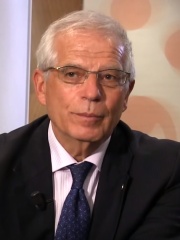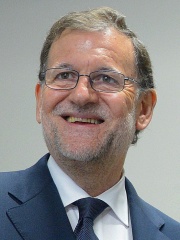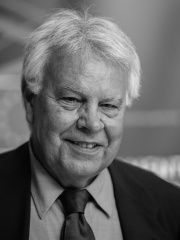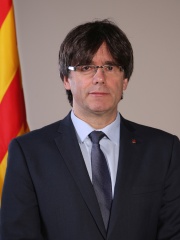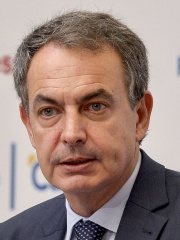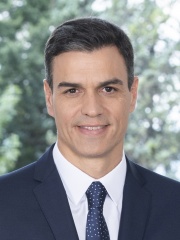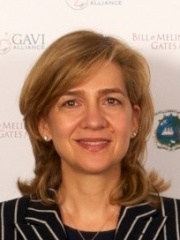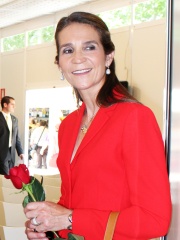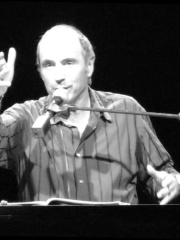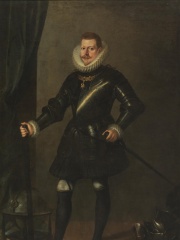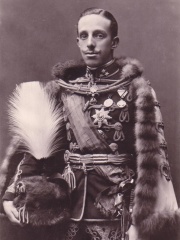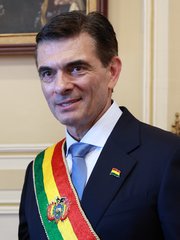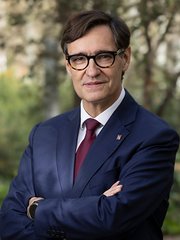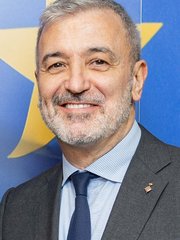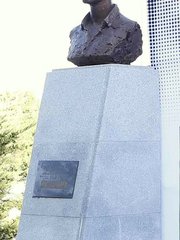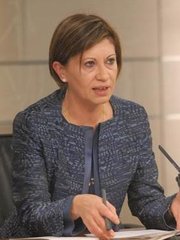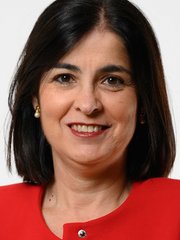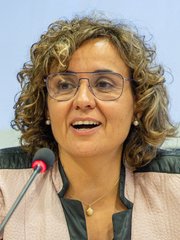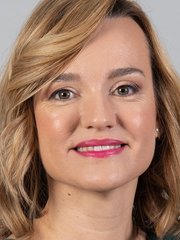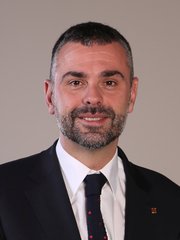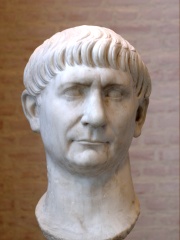
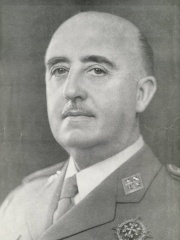
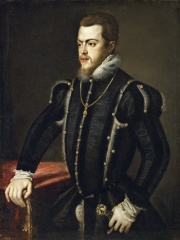
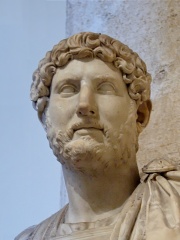
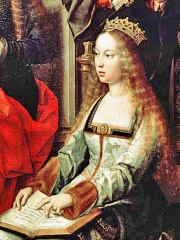
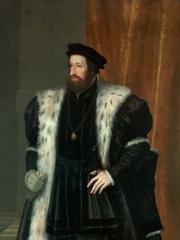
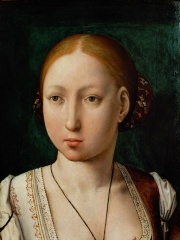
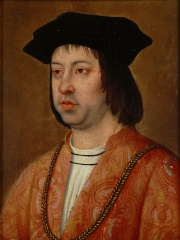
The Most Famous
POLITICIANS from Spain
This page contains a list of the greatest Spanish Politicians. The pantheon dataset contains 19,576 Politicians, 536 of which were born in Spain. This makes Spain the birth place of the 7th most number of Politicians behind United Kingdom, and Russia.
Top 10
The following people are considered by Pantheon to be the top 10 most legendary Spanish Politicians of all time. This list of famous Spanish Politicians is sorted by HPI (Historical Popularity Index), a metric that aggregates information on a biography's online popularity. Visit the rankings page to view the entire list of Spanish Politicians.

1. Trajan (53 - 117)
With an HPI of 85.85, Trajan is the most famous Spanish Politician. His biography has been translated into 110 different languages on wikipedia.
Trajan ( TRAY-jən; born Marcus Ulpius Traianus, 18 September 53 – c. 9 August 117) was a Roman emperor from AD 98 to 117, remembered as the second of the Five Good Emperors of the Nerva–Antonine dynasty. He was a philanthropic ruler and a successful soldier-emperor who presided over one of the greatest military expansions in Roman history, during which, by the time of his death, the Roman Empire reached its maximum territorial extent. He was given the title of Optimus ('the best') by the Roman Senate. Trajan was born in the municipium of Italica in the present-day Andalusian province of Seville in southern Spain, an Italic settlement in Hispania Baetica; his gens Ulpia came from the town of Tuder in the Umbria region of central Italy. His namesake father, Marcus Ulpius Traianus, was a general and distinguished senator. Trajan rose to prominence during the reign of Domitian; in AD 89, serving as a legatus legionis in Hispania Tarraconensis, he supported the emperor against a revolt on the Rhine led by Antonius Saturninus. He then served as governor of Germania and Pannonia. In September 96, Domitian was succeeded by the elderly and childless Nerva, who proved to be unpopular with the army. After a revolt by members of the Praetorian Guard, Nerva decided to adopt as his heir and successor the more popular Trajan, who had distinguished himself in military campaigns against Germanic tribes. As emperor of Rome, Trajan oversaw the construction of building projects such as the forum named after him, the expansion of social welfare policies such as the alimenta, and new military conquests. He annexed Nabataea and Dacia, and his war against the Parthian Empire ended with the incorporation of Armenia, Mesopotamia, and Assyria as Roman provinces. In August AD 117, while sailing back to Rome, Trajan fell ill and died of a stroke in the city of Selinus. He was deified by the senate and his successor Hadrian (Trajan's cousin). According to historical tradition, Trajan's ashes were entombed in a small room beneath Trajan's Column.

2. Francisco Franco (1892 - 1975)
With an HPI of 85.72, Francisco Franco is the 2nd most famous Spanish Politician. His biography has been translated into 117 different languages.
Francisco Paulino Hermenegildo Teódulo Franco Bahamonde (4 December 1892 – 20 November 1975) was a Spanish general and dictator who led the Nationalist forces in overthrowing the Second Spanish Republic during the Spanish Civil War and thereafter ruled over Spain from 1939 until his death in 1975. This period in Spanish history, from the Nationalist victory to Franco's death, is commonly known as Francoist Spain. Born in Ferrol, Galicia, into an upper-class military family, Franco served in the Spanish Army as a cadet in the Toledo Infantry Academy from 1907 to 1910. While serving in Morocco, he rose through the ranks to become a brigadier general in 1926 at age 33. Two years later, Franco became the director of the General Military Academy in Zaragoza. As a conservative and monarchist, Franco regretted the abolition of the monarchy and the establishment of the Second Republic in 1931, and was devastated by the closing of his academy; nevertheless, he continued his service in the Republican Army. His career was boosted after the right-wing CEDA and PRR won the 1933 election, empowering him to lead the suppression of the 1934 uprising in Asturias. Franco was briefly elevated to Chief of Army Staff before the 1936 election moved the leftist Popular Front into power, relegating him to the Canary Islands. He joined the July 1936 military coup, which, after failing to take Spain, sparked the Spanish Civil War. He commanded Spain's African colonial army and later, following the deaths of much of the rebel leadership, became his faction's only leader, being appointed generalissimo and head of state in 1936. He became recognized as a fascist leader while receiving support from Fascist Italy and Nazi Germany. He consolidated all Nationalist groups into the FET y de las JONS, and developed a cult of personality around his rule by founding the Movimiento Nacional. Three years later the Nationalists declared victory, which extended Franco's rule over Spain through a period of repression of political opponents. His government's use of forced labour, concentration camps and executions after the war led to at least 30,000 deaths, with some estimates exceeding 200,000. Combined with wartime killings, this brings the death toll of the White Terror to between 100,000 and 350,000 or more. During World War II, he maintained Spanish neutrality, but supported the Axis powers, damaging the country's international reputation. During the start of the Cold War, Franco lifted Spain out of its mid-20th century economic depression through technocratic and economically liberal policies, presiding over a period of accelerated growth known as the "Spanish miracle". At the same time, his regime transitioned from a totalitarian state to an authoritarian one with limited pluralism. He became a leader in the anti-communist movement, garnering support from the West, particularly the United States. As the government relaxed its hard-line policies, Luis Carrero Blanco became Franco's éminence grise, whose role expanded after Franco began struggling with Parkinson's disease in the 1960s. In 1973, Franco resigned as prime minister—separated from the office of head of state since 1967—due to his advanced age and illness. Nevertheless, he remained in power as the head of state and as commander-in-chief. Franco died in 1975, aged 82, and was entombed in the Valle de los Caídos. He restored the monarchy in his final years, being succeeded by King Juan Carlos, who led the Spanish transition to democracy. The legacy of Franco in Spanish history remains controversial, as the nature of his rule changed over time. His reign was marked by both brutal repression, with tens of thousands killed, and economic prosperity, which greatly improved the quality of life in Spain. His style proved adaptable enough to allow social and economic reform, but still centred on highly centralised government, authoritarianism, nationalism, national Catholicism, anti-freemasonry and anti-communism. The contemporaries regarded Franco as a fascist dictator; among scholars, there has been a long-lasting debate whether it is adequate to define Franco's regime as fascist. It has been described in broad definitions, from a traditional military dictatorship to a fascistized yet not fascist or a fully fascist regime.

3. Philip II of Spain (1527 - 1598)
With an HPI of 84.79, Philip II of Spain is the 3rd most famous Spanish Politician. His biography has been translated into 96 different languages.
Philip II (21 May 1527 – 13 September 1598), sometimes known in Spain as Philip the Prudent (Spanish: Felipe el Prudente), was King of Spain from 1556, King of Portugal from 1580, and King of Naples and Sicily from 1554 until his death in 1598. He was also jure uxoris King of England and Ireland from his marriage to Queen Mary I in 1554 until her death in 1558. Further, he was Duke of Milan from 1540. From 1555, he was Lord of the Seventeen Provinces of the Netherlands. The son of Emperor Charles V and Isabella of Portugal, Philip inherited his father's Spanish Empire in 1556, and succeeded to the Portuguese throne in 1580 following a dynastic crisis, forming the Iberian Union. The Spanish conquests of the Inca Empire and of the Philippines, named in his honour by Ruy López de Villalobos, were completed during his reign. He finished building the royal palace El Escorial in 1584. Under Philip II, Spain reached the height of its influence and power, advancing into the Spanish Golden Age, and ruled territories in every continent then known to Europeans. Deeply devout, Philip saw himself as the defender of Catholic Europe against the Ottoman Empire and the Protestant Reformation, and invested Spain's position as the leading European power in multiple simultaneous warring efforts. During his reign, Spain participated in notable victories against the Ottomans in Oran, Malta and Lepanto. In 1584, during the Eighty Years' War, Philip signed the Treaty of Joinville, funding the French Catholic League over the following decade against the French Huguenots. In 1588, he sent an armada to invade Protestant England, with the strategic aim of overthrowing his former sister-in-law Elizabeth I and re-establishing Catholicism there, but his fleet was repulsed in a skirmish and wrecked by storms as it returned to Spain. Philip's naval power recovered after the defeat of a similarly sized English Armada sent against Spain. As a consequence of these conflicts, Philip led a highly debt-leveraged regime, seeing state defaults in 1557, 1560, 1569, 1575, and 1596. An ambitious plan to extend his conquests to China and across Asia was also considered and abandoned. Historical reception of Philip II became heavily influenced by enemy propaganda, which he refused to answer or defend himself against, even prohibiting biographical accounts of his life. His negative foreign reputation eventually developed into the Spanish Black Legend, while reappraisals of his figure would later entangle in turn with the White Legend. As a result, historian Helmut Koenigsberger would write about Philip, "there has, perhaps, been no personality in modern history, not even Napoleon or Stalin, who has been both as enigmatic and controversial as Philip II of Spain... Neither his own contemporaries nor later historians have been able to agree on his character, his aims or even the degree of success he achieved."

4. Hadrian (76 - 138)
With an HPI of 84.58, Hadrian is the 4th most famous Spanish Politician. His biography has been translated into 96 different languages.
Hadrian ( HAY-dree-ən; born Publius Aelius Hadrianus, 24 January 76 – 10 July 138) was Roman emperor from 117 to 138. Hadrian was born in Italica, in the present-day Andalusian province of Seville in southern Spain, an Italic settlement in Hispania Baetica; his gens Aelia came from the town of Hadria in eastern Italy. He was a member of the Nerva–Antonine dynasty. Early in his political career, Hadrian married Vibia Sabina, grandniece of the ruling emperor, Trajan, and his second cousin once removed. The marriage and Hadrian's later succession as emperor were probably promoted by Trajan's wife Pompeia Plotina. Soon after his own succession, Hadrian had four leading senators unlawfully put to death, probably because they seemed to threaten the security of his reign; this earned him the senate's lifelong enmity. He earned further disapproval by abandoning Trajan's expansionist policies and territorial gains in Mesopotamia, Assyria, Armenia, and parts of Dacia. Hadrian preferred to invest in the development of stable, defensible borders and the unification of the Roman empire's disparate peoples and subjects. He was a promoter of philhellenism. Hadrian energetically pursued his own Imperial ideals and personal interests. He visited almost every province of the Empire, and indulged a preference for direct intervention in imperial and provincial affairs, especially building projects. He is particularly known for building Hadrian's Wall, which marked the northern limit of Britannia. In Rome itself, he rebuilt the Pantheon and constructed the vast Temple of Venus and Roma. In Egypt, he may have rebuilt the Serapeum of Alexandria. As an ardent admirer of Greek culture, he promoted Athens as the cultural capital of the Empire. His intense relationship with Greek youth Antinous and the latter's untimely death led Hadrian to establish a widespread, popular cult. Late in Hadrian's reign, he suppressed the Bar Kokhba revolt, which he saw as a failure of his universal project and philhellenic ideal. Hadrian's last years were marred by chronic illness. His marriage had been both unhappy and childless. In 138, he adopted Antoninus Pius and nominated him as a successor, on condition that Antoninus adopt Marcus Aurelius and Lucius Verus as his own heirs. Hadrian died the same year at Baiae, and Antoninus had him deified, despite opposition from the Senate. Later historians counted him as one of Rome's so-called "Five Good Emperors", and as a benevolent autocrat. His own Senate found him remote and authoritarian. He has been described as enigmatic and contradictory, with a capacity for both great personal generosity and extreme cruelty and driven by insatiable curiosity, conceit, and ambition.
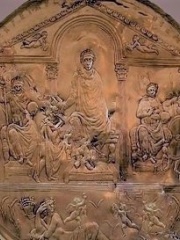
5. Theodosius I (340 - 395)
With an HPI of 83.74, Theodosius I is the 5th most famous Spanish Politician. His biography has been translated into 86 different languages.
Theodosius I (Ancient Greek: Θεοδόσιος Theodosios; 11 January 347 – 17 January 395), also known as Theodosius the Great, was Roman emperor from 379 to 395. He won two civil wars and was instrumental in establishing the Nicene Creed as the orthodox doctrine for Nicene Christianity. Theodosius was the last emperor to rule the entire Roman Empire before its administration was permanently split between the Western Roman Empire and the Eastern Roman Empire. He ended the Gothic War (376–382), but did so on terms disadvantageous to the empire, with the Goths remaining and politically autonomous within Roman territory, albeit as nominal allies. Born in Hispania, Theodosius was the son of a high-ranking general of the same name, Theodosius the Elder, under whose guidance he rose through the ranks of the Roman army. Theodosius held independent command in Moesia in 374, where he had some success against the invading Sarmatians. Not long afterwards, he was forced into retirement, and his father was executed under obscure circumstances. Theodosius soon regained his position following a series of intrigues and executions at Emperor Gratian's court. In 379, after the eastern Roman emperor Valens was killed at the Battle of Adrianople against the Goths, Gratian appointed Theodosius as a successor with orders to take charge of the military emergency. The new emperor's resources and depleted armies were not sufficient to drive the invaders out; in 382 the Goths were allowed to settle south of the Danube as autonomous allies of the empire. In 386, Theodosius signed a treaty with the Sasanian Empire which partitioned the long-disputed Kingdom of Armenia and secured a durable peace between the two powers. Theodosius was a strong adherent of the Christian doctrine of consubstantiality and an opponent of Arianism. He convened a council of bishops at the First Council of Constantinople in 381, which confirmed the former as orthodoxy and the latter as a heresy. Although Theodosius interfered little in the functioning of traditional pagan cults and appointed non-Christians to high offices, he failed to prevent or punish the damaging of several Hellenistic temples of classical antiquity, such as the Serapeum of Alexandria, by Christian zealots. During the earlier part of his reign, Theodosius ruled the eastern provinces, while the west was overseen by the emperor Gratian (and nominally with Valentinian II, his young co-emperor). In 386, he married Valentinian's sister, Galla, the marriage arranged to consolidate Theodosius' political and military power. Theodosius sponsored several measures to improve Constantinople, his capital and main place of residence—notably his expansion of the Forum Tauri, which became the biggest public square known in antiquity. Theodosius marched west twice, in 388 and 394, after Gratian and then Valentinian had been killed and replaced by the usurper Magnus Maximus and Eugenius. Theodosius's final military victory in September 394 made him ruler of the entire empire; he died however only a few months later and was succeeded by his two young sons (and by that stage co-emperors): Arcadius in the eastern half of the empire and Honorius in the west. Theodosius was said to have been a diligent administrator, austere in his habits, merciful, and a devout Christian. In the centuries after his death, Theodosius was regarded as a champion of Christian orthodoxy who decisively stamped out paganism; however, modern scholars tend to see this as an interpretation of history by Christian writers more than as an accurate representation of actual history. He is fairly credited with presiding over a revival in classical art that some historians have termed a "Theodosian renaissance". Although his pacification of the Goths secured peace for the Empire during his lifetime, their status as an autonomous entity within Roman borders caused problems for succeeding emperors. Theodosius has also received criticism for defending his own dynastic interests at the cost of two civil wars. His two sons proved weak and incapable rulers, and they presided over a period marked by foreign invasions and court intrigues, seriously weakening the empire(s). However, the descendants of Theodosius did rule the Roman world for the next six decades, and the east–west division endured—until the fall of the Western Roman Empire in the late 5th century.

6. Isabella I of Castile (1451 - 1504)
With an HPI of 83.02, Isabella I of Castile is the 6th most famous Spanish Politician. Her biography has been translated into 93 different languages.
Isabella I (Spanish: Isabel I; 22 April 1451 – 26 November 1504), also called Isabella the Catholic (Spanish: Isabel la Católica), was Queen of Castile and León from 1474 until her death in 1504. She was also Queen of Aragon from 1479 until her death as the wife of King Ferdinand II. Reigning together over a dynastically unified Spain, Isabella and Ferdinand are known as the Catholic Monarchs. Her reign marked the end of the Reconquista and also the start of the Spanish Empire, allowing Spain to dominate European politics for the next century. Isabella's marriage to Ferdinand of Aragon in 1469 created the basis of the de facto unification of Spain. With Ferdinand's help, she won the War of the Castilian Succession, securing her position as Queen of Castille. Isabella reorganized the governmental system, brought the crime rate down, and unburdened the kingdom of the debt which her half-brother King Henry IV had left behind. Her reforms and those she made with her husband had an influence that extended well beyond the borders of their united kingdoms. Isabella and Ferdinand are known for being the first monarchs to be referred to as the queen and king of Spain, respectively. Their actions included completion of the Reconquista, the Alhambra Decree which ordered the mass expulsion of Jews from Spain, initiating the Spanish Inquisition, financing Christopher Columbus's 1492 voyage to the New World, and establishing the Spanish Empire, making Spain a major power in Europe and the world and ultimately ushering in the Spanish Golden Age. Together with her husband, Isabella was granted the title of "Catholic Monarch" by Pope Alexander VI, a Spaniard. Her sainthood cause was opened in 1958, and in 1974 she was granted the title of Servant of God in the Catholic Church.

7. Ferdinand I, Holy Roman Emperor (1503 - 1564)
With an HPI of 82.71, Ferdinand I, Holy Roman Emperor is the 7th most famous Spanish Politician. His biography has been translated into 70 different languages.
Ferdinand I (10 March 1503 – 25 July 1564) was Holy Roman Emperor from 1556, King of Bohemia, Hungary, and Croatia from 1526, and Archduke of Austria from 1521 until his death in 1564. Before his accession as emperor, he ruled the Austrian hereditary lands of the House of Habsburg in the name of his elder brother, Emperor Charles V, and often served as Charles' representative in developing encouraging relationships with German princes. In addition, Ferdinand also developed valuable relationships with the German banking house of Jakob Fugger and the Catalan bank, Banca Palenzuela Levi Kahana. The key events during Ferdinand's reign were the conflict with the Ottoman Empire, which in the 1520s began a great advance into Central Europe, and the Protestant Reformation, which resulted in several wars of religion. Although not a military leader, Ferdinand was a capable organizer with institutional imagination who focused on building a centralized government for Austria, Hungary, and Bohemia instead of striving for universal monarchy. He reintroduced major innovations of his grandfather Maximilian I such as the Hofrat (court council) with a chancellery and a treasury attached to it (this time, the structure would last until the reform of Maria Theresa) and added innovations of his own such as the Raitkammer (collections office) and the Hofkriegsrat, conceived to counter the threat from the Ottoman Empire, while also successfully subduing the most radical of his rebellious Austrian subjects and turning the political class in Bohemia and Hungary into Habsburg partners. While he was able to introduce uniform models of administration, the governments of Austria, Bohemia and Hungary remained distinct. His approach to Imperial problems, including governance, human relations and religious matters was generally flexible, moderate and tolerant. Ferdinand's motto was Fiat iustitia, et pereat mundus: "Let justice be done, though the world perish".

8. Joanna of Castile (1479 - 1555)
With an HPI of 82.66, Joanna of Castile is the 8th most famous Spanish Politician. Her biography has been translated into 68 different languages.
Joanna of Castile (6 November 1479 – 12 April 1555), historically known as Joanna the Mad (Spanish: Juana la Loca), was the nominal queen of Castile from 1504 and queen of Aragon from 1516 to her death in 1555. She was the daughter of Queen Isabella I of Castile and King Ferdinand II of Aragon. Joanna was married by arrangement to the Austrian archduke Philip the Handsome on 20 October 1496. Following the deaths of her elder brother John, elder sister Isabella, and nephew Miguel between 1497 and 1500, Joanna became the heir presumptive to the crowns of Castile and Aragon. When her mother died in 1504, she became queen of Castile. Her father proclaimed himself governor and administrator of Castile. In 1506, Joanna's husband Philip became king of Castile jure uxoris as Philip I, initiating the rule of the Habsburgs in the Spanish kingdoms. Philip died that same year. Despite being the ruling queen of Castile, Joanna had little effect on national policy during her reign as she was declared insane and confined in the Royal Palace in Tordesillas under the orders of her father, who ruled as regent until his death in 1516, when she inherited his kingdom as well. Her son Charles I became king, and during his reign Joanna was nominally co-monarch but remained confined until her death. Joanna died aged 75 in 1555, at which point her son Charles, the Holy Roman Emperor, became the sole ruler of Castile and Aragon.

9. Ferdinand II of Aragon (1452 - 1516)
With an HPI of 80.98, Ferdinand II of Aragon is the 9th most famous Spanish Politician. His biography has been translated into 82 different languages.
Ferdinand II, also known as Ferdinand I, Ferdinand III, and Ferdinand V (10 March 1452 – 23 January 1516), called Ferdinand the Catholic, was King of Aragon from 1479 until his death in 1516. As the husband and co-ruler of Queen Isabella I of Castile, he was also King of Castile from 1475 to 1504 (as Ferdinand V). He reigned jointly with Isabella over a dynastically unified Spain; together they are known as the Catholic Monarchs. Ferdinand is considered the de facto first king of Spain, and was described as such during his reign, even though, legally, Castile and Aragon remained two separate kingdoms until they were formally united by the Nueva Planta decrees issued between 1707 and 1716. The Crown of Aragon that Ferdinand inherited in 1479 included the kingdoms of Aragon, Valencia, Mallorca, Sardinia, and Sicily, as well as the Principality of Catalonia. His marriage to Isabella is regarded as the "cornerstone in the foundation of the Spanish monarchy". They played a major role in the European colonization of the Americas, sponsoring the first voyage of Christopher Columbus in 1492. That year the couple defeated Granada, the last Muslim state in Western Europe, thus completing the centuries-long Reconquista. Following Isabella's death in 1504, the couple's daughter Joanna became queen of the Crown of Castile. That year, after a war with France, Ferdinand conquered the Kingdom of Naples. In 1507 he became regent of Castile on behalf of Joanna, who was alleged to be mentally unstable. In 1506, as part of a treaty with France, Ferdinand married Germaine of Foix, with whom he had no surviving children. In 1512 he conquered most of the Kingdom of Navarre, ruling all the territories comprising modern-day Spain until his death in 1516. He was nominally succeeded by his daughter Joanna, but power was soon assumed by her son Charles I (later Holy Roman Emperor Charles V).
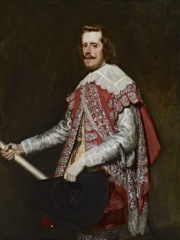
10. Philip IV of Spain (1605 - 1665)
With an HPI of 80.78, Philip IV of Spain is the 10th most famous Spanish Politician. His biography has been translated into 73 different languages.
Philip IV (Spanish: Felipe Domingo Victor de la Cruz de Austria y Austria, Portuguese: Filipe III; 8 April 1605 – 17 September 1665), also called the Planet King (Spanish: Rey Planeta), was King of Spain from 1621 to his death and (as Philip III) King of Portugal from 1621 to 1640. Philip is remembered for his patronage of the arts, including such artists as Diego Velázquez, and his rule over Spain during the Thirty Years' War. By the time of his death, the Spanish Empire had reached approximately 12.2 million square kilometres (4.7 million square miles) in area, the largest empire in the world, but in other aspects was in decline, a process to which Philip contributed with his inability to achieve successful domestic and military reform. He was succeeded on his death by his young son Charles II as King of Spain and in 1640 (with the collapse of the Iberian Union) by John IV as King of Portugal.
People
Pantheon has 536 people classified as Spanish politicians born between 250 BC and 2000. Of these 536, 145 (27.05%) of them are still alive today. The most famous living Spanish politicians include Josep Borrell, Mariano Rajoy, and Felipe González. The most famous deceased Spanish politicians include Trajan, Francisco Franco, and Philip II of Spain. As of April 2024, 22 new Spanish politicians have been added to Pantheon including Rodrigo Paz, Salvador Illa, and Jaume Collboni.
Living Spanish Politicians
Go to all RankingsJosep Borrell
1947 - Present
HPI: 72.83
Mariano Rajoy
1955 - Present
HPI: 70.38
Felipe González
1942 - Present
HPI: 69.16
Carles Puigdemont
1962 - Present
HPI: 68.27
José María Aznar
1953 - Present
HPI: 66.96
José Luis Rodríguez Zapatero
1960 - Present
HPI: 66.94
Pedro Sánchez
1972 - Present
HPI: 66.77
Anne Hidalgo
1959 - Present
HPI: 66.14
Infanta Cristina of Spain
1965 - Present
HPI: 65.96
Infanta Elena, Duchess of Lugo
1963 - Present
HPI: 65.50
Lluís Llach
1948 - Present
HPI: 65.09
Manuel Valls
1962 - Present
HPI: 62.34
Deceased Spanish Politicians
Go to all RankingsTrajan
53 - 117
HPI: 85.85
Francisco Franco
1892 - 1975
HPI: 85.72
Philip II of Spain
1527 - 1598
HPI: 84.79
Hadrian
76 - 138
HPI: 84.58
Theodosius I
340 - 395
HPI: 83.74
Isabella I of Castile
1451 - 1504
HPI: 83.02
Ferdinand I, Holy Roman Emperor
1503 - 1564
HPI: 82.71
Joanna of Castile
1479 - 1555
HPI: 82.66
Ferdinand II of Aragon
1452 - 1516
HPI: 80.98
Philip IV of Spain
1605 - 1665
HPI: 80.78
Philip III of Spain
1578 - 1621
HPI: 79.91
Alfonso XIII of Spain
1886 - 1941
HPI: 79.90
Newly Added Spanish Politicians (2025)
Go to all RankingsRodrigo Paz
1967 - Present
HPI: 58.66
Salvador Illa
1966 - Present
HPI: 54.32
Jaume Collboni
1969 - Present
HPI: 49.91
Miguel Ángel Blanco
1968 - 1997
HPI: 47.71
Cayetana Álvarez de Toledo
1974 - Present
HPI: 46.40
Izaskun Bilbao Barandica
1961 - Present
HPI: 46.39
Elena Espinosa
1960 - Present
HPI: 45.72
Carolina Darias
1965 - Present
HPI: 45.15
Dolors Montserrat
1973 - Present
HPI: 44.29
Pilar Alegría
1977 - Present
HPI: 43.01
Ione Belarra
1987 - Present
HPI: 41.34
Santi Vila
1973 - Present
HPI: 40.84
Overlapping Lives
Which Politicians were alive at the same time? This visualization shows the lifespans of the 25 most globally memorable Politicians since 1700.

